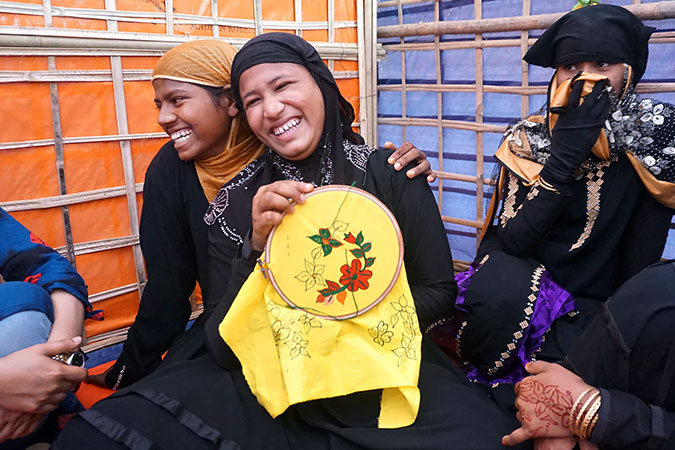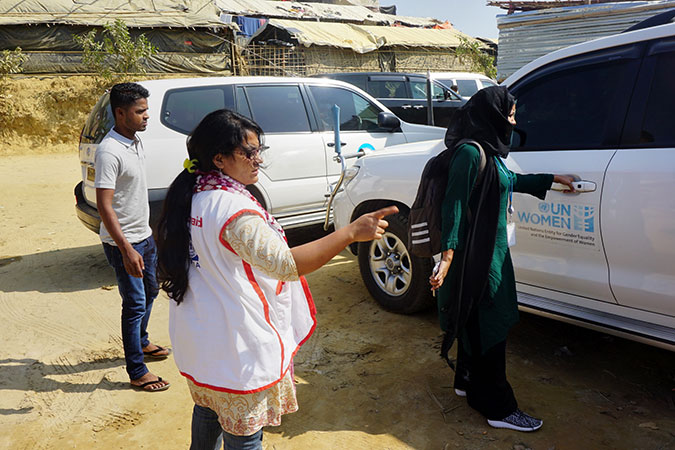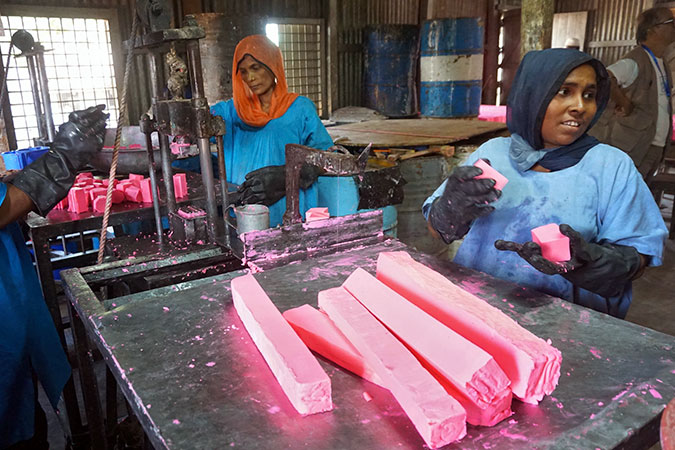“I want to help other women”—Rohingya women strive to reclaim a life of dignity
Date:
Author: Marie Sophie Pettersson

About the author
Marie Sophie Pettersson is Humanitarian Action and Resilience Building Programme Specialist with UN Women, currently working in Myanmar. She visited Cox’s Bazar, Bangladesh, from October-December 2017 to support UN Women’s engagement in the Rohingya Refugee Crisis Response. Marie Sophie has worked with UN Women since 2014 in crisis and disaster response, recovery, preparedness and resilience building. Prior to joining UN Women, she worked in Bangladesh on economic empowerment programmes and innovations to address poverty.
The absence of women was the first thing I noticed when I entered the Rohingya refugee camps in Cox’s Bazar, Bangladesh. It was a late October morning, but unbearably hot. There were 10 camps, hosting over 800,000[1] people. I could see men and children everywhere, receiving relief items from the humanitarian actors, selling snacks and goods, fetching water and fire wood…men praying in the mosques and children attending classes in the temporary learning centres. But where were the women?
Bangladesh has been hosting Rohingya refugees from Myanmar for nearly three decades. In recent times, the escalating violence in Rakhine State, Myanmar, has displaced some 688,000[2] Rohingyas since August 2017. The refugee population in Bangladeshi settlements has more than doubled; camps are overcrowded, needs are immediate and enormous, and resources are stretched.
The Rohingya refugees arrived by the boat, every day, fleeing killings, torture, rape and other forms of sexual violence. They arrived with very few possessions, impoverished and traumatized. The majority, just above half, of the estimated 688,000 new arrivals, are women and girls.
Crisis situations often impact women and girls more, and differently than men and boys because the existing gender inequalities are compounded. The Rohingya crisis is not any different. In fact, going into the camps for the first time, I already knew the crisis had a distinctly gendered face because of the high levels of sexual violence and stark gender segregation that Rohingya women and girls have experienced. So where were the women?

Upon a closer look, I finally spotted them—silhouettes inside the tents, few faces peeking out as we walked past. The Rohingya women and girls often live under restrictive socio-cultural norms. The violence they have experienced and witnessed in Myanmar has made their movements even more restrictive. They are also at risk of gender-based violence, sexual exploitation and abuse within the refugee camps in Cox’s Bazar, Bangladesh. While the men showed up for meetings and distribution of relief items, were consulted about their needs, and had a say in decisions being made within the camps, the women were mostly sidelined. They had limited access to information, livelihood options, community activities and decision-making. They even lacked adequate sanitation facilities.
Without women’s voice and active participation, the humanitarian action being designed and delivered would be missing critical information—what were the needs and priorities of the Rohingya women and girls? How were they faring?
My job was to talk to Rohingya women in the refugee camps, and make sure that the humanitarian action in Cox’s Bazar was shaped by their voices, protected their rights and met their unique needs.
A 12-year-old Rohingya girl, Amina stood by a dusty street in the Balukhali refugee camp, selling rice cake. “We arrived in this camp one month ago,” she said. “My mother stays at home and cooks these snacks in our shed every day and I sell them here on the street…that way we make some extra money to buy vegetables and other items we need for our family, as the relief we got from the UN and the money we got from selling my mum’s jewelry was not enough.”
“My mum can't leave the shed out of modesty as she doesn't have her burqa here and there are many people we don't know in the camp,” she continued. “The shed gets very hot and humid and there's not much space. It gets full of heavy smoke from the wood fuel we use to cook, which hurts my mother’s eyes and throat”.
I went inside their shed— around 4 square metre wide—and saw that Amina and her mother Fatema Khatun* had built a make-shift toilet and bathing area, partitioned from the living space with pieces of tarp—hardly adequate or hygienic, but like most other women and girls, they do not use the shared toilets in the camp. Even when there are female-only toilets or bathing areas, the men often lurk around them and try to look inside. To avoid open bathing and defecation, many women and girls use make-shift toilets inside their sheds, reduce their food and water intake, and restrict their movements during menstruation.
The Rohingya women who are used to wearing a burqa talked about feeling unsafe going outside their shelters without one. Women have started sharing a burqa among themselves to access public spaces. Since women and girls mostly stay inside the unventilated shelters all day, they are also exposed to the smoke and toxic emissions from the firewood that they use for cooking. Many reported respiratory problems and eye infections.

Every day, for seven days a week, I visited the camp and the surrounding villages in the morning, gathering women’s needs and opinions. In the afternoons, I would go back to the centre to share what I had learned at the humanitarian coordination meetings, where representatives from the government, the UN, and non-governmental humanitarian organizations came together to plan and make decisions about the crisis response. For instance, based on what I heard from the women, I led the drafting of the Gender Profile brief, which shaped the measures in overall crisis response. Until now, midwives and gynecologists were not allowed to enter the refugee camps between 5 p.m. and 7 a.m., leaving many Rohingya women with no qualified medical help during childbirth and reproductive health needs during those hours. With our recommendation, the Gender Profile included the provision of granting women health workers permission to enter the camps after 5 p.m.—a seemingly simple adjustment that makes a world of difference to women in the refugee camps.
At times, given the enormity of the needs, the task at hand seemed almost impossible. But how could we not persevere, knowing the inhumane violence that the Rohingyas have experienced and seeing their incredible will to survive. We pushed on, harder, to make sure that women’s voices were heard by the government, the UN, the non-profit organizations, the donors and the army. What we learned from the women also shaped UN Women’s humanitarian and resilience building programme in Cox’s Bazar, in partnership with the Ministry of Women and Children Affairs of Bangladesh.

For instance, as part of our first response, UN Women, together with Action Aid, distributed kits to nearly 8,000 Rohingya women refugees, which had soaps, clothes, scarves, menstrual hygiene products and flashlights for women, as well as blankets for the winter cold and alternative fuel—compressed rice husk briquettes—to reduce their exposure to smoke.
After visiting the camps, I made my way to the nearby village of Teknaf, where I met with Bangladeshi women leaders of the community. They were elected members of the Women Development Forum and elected village forum leaders, and had been part of another UN Women programme implemented in partnership with BRAC, and funded by the Government of Japan, to improve social cohesion and women’s economic empowerment. Talking to the host communities around the camp and building cohesion between the newly arrived refugee women and Bangladeshi women is critical. While the Bangladeshis have been largely sympathetic about the unfolding crisis over decades, the recent surge of refugees from Myanmar is a strain on existing resources.
That day, the Bangladeshi women shared their optimistic vision: "When the Rohingya came into our village from the Myanmar border, we wanted to help them. We hosted the Rohingya women and children in our homes and helped those who were pregnant give birth. We gave them food and clothes, and tried to help the best we could, although we are ourselves poor.”
“We want to help more Rohingya women staying in the camps. We can support each other and start a Bangladeshi-Rohingya women's network and entrepreneurship for peace," added Sharmin Alam*, a member of the forum of women leaders.
It was 7 p.m. by the time I was in a “tom tom” (local electric taxis), on my way back home. The driver told me his business was booming, ferrying all the international workers in town. Local Bangla music streamed out of the radio, there were green hills on one side of the road and the beach on the other side. There were people on the streets, the markets were still bustling. My mind returned to the stories I had heard that day.

The Rohingya women and girls I met are not merely vulnerable victims, waiting for handouts. They have seen and experienced immense suffering, had homes that they have lost, livelihoods that are now destroyed, families that have been torn apart, sometimes quite literally. But they have the strength to overcome, skills to contribute, experience and knowledge to build resilience of families and communities, and dreams of a life of dignity and freedom from violence that is their right.
The Rohingya women and girls I met are not merely vulnerable victims, waiting for handouts. They have seen and experienced immense suffering, had homes that they have lost, livelihoods that are now destroyed, families that have been torn apart, sometimes quite literally. But they have the strength to overcome, skills to contribute, experience and knowledge to build resilience of families and communities, and dreams of a life of dignity and freedom from violence that is their right.
Notes
[1] As of 21 January 2018, 821,436 refugees are hosted in the camp, as per the ISCG Situation Report.
[2] As of 21 January 2018, ISCG Situation Report.
Note: The real names of Rohingya and Bangladeshi women in this story have been withheld to protect their identity and to avoid stigmatization.
As of January 2018, UN Women has set up the first Multi-Purpose Women Centre in the Bhalukhali refugee camp in Cox’s Bazar, in partnership with Action Aid and with support from UN Women National Committee Australia. The Centre provides a safe space for Rohingya women and adolescent girls, where they can build a social network, access information and referral services for gender-based violence, and seek psycho-social counselling. The centre also offers skills training in literacy, livelihood options, leadership and disaster preparedness, and raises awareness about gender issues and risks. Plans are underway to build additional Multi-Purpose Women Centres, and to engage Rohingya refugee women leaders from the older registered camps and Bangladeshi women from the host communities to provide skills training and mentoring to the newly arrived Rohingya women refugees and form joint support groups to build peace and cohesion.